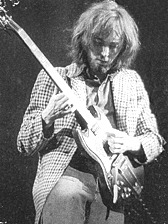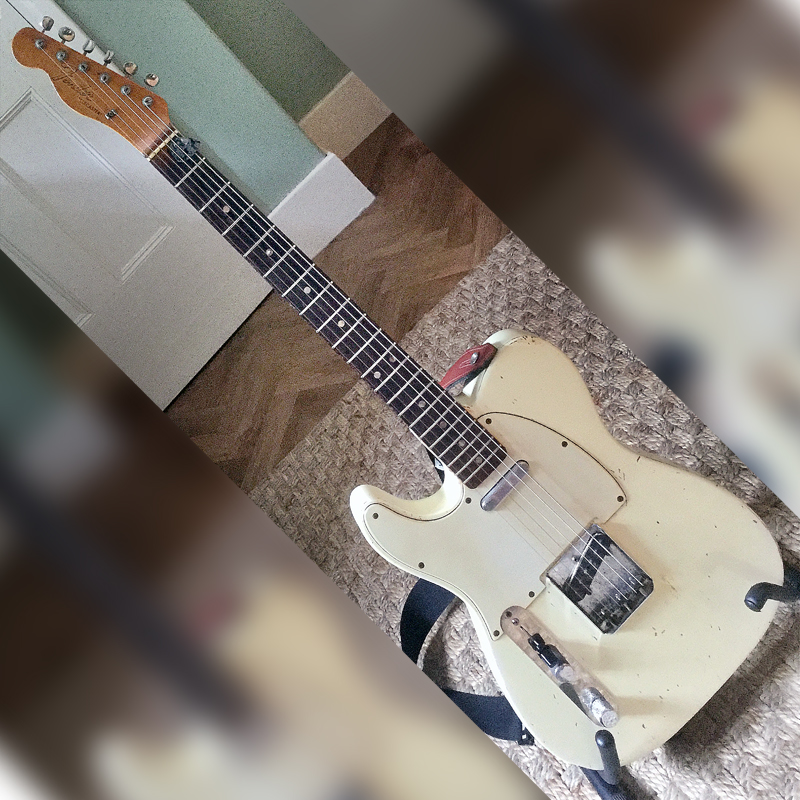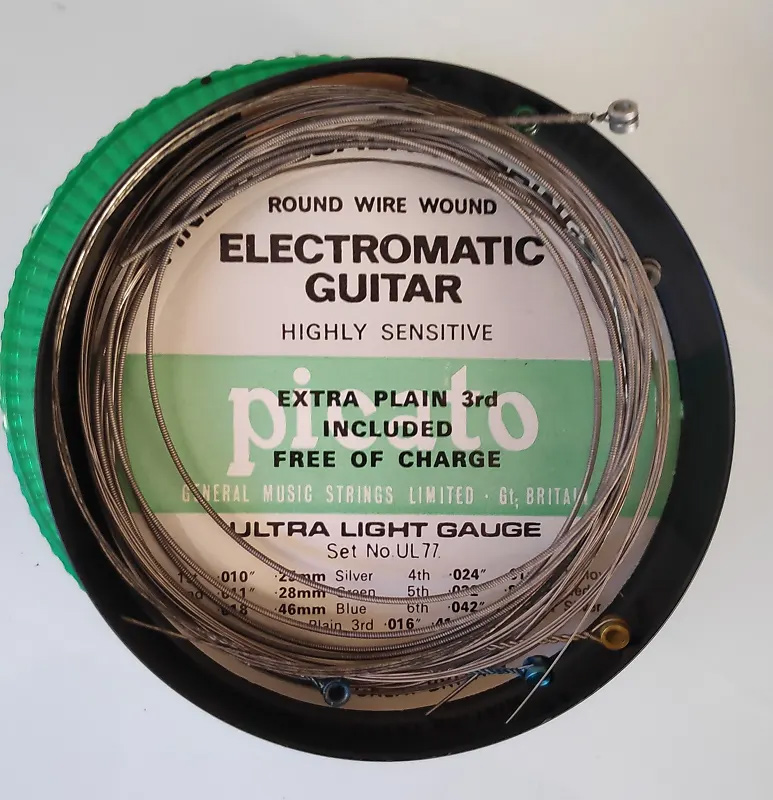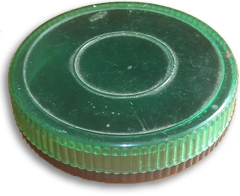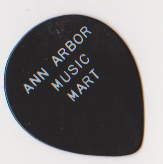Guitar Technique
When an article was first suggested about the more 'technical' side of Ollie's work I pictured the worst excesses of 'Univibes' - the otherwise excellent Hendrix magazine. This offers note by note analysis of improvisations (a contradiction in itself) in a musicspeak of 'motifs', 'relative minors' and '6ths' - recalling the 'aeolian cadences' and 'pentatonic clusters' once attributed to Lennon and McCartney. The truth in both instances, of course, is that the artistes worked intuitively on their own terms, defying such academic appraisal. Halsall's contributions (for which I make no apology whatsoever for placing in the same company) are equally impossible to annotate meaningfully.
Like all virtuosi, Ollie had a total understanding of musical theory. I have no idea whether he could read formal notation and it is of little significance anyway. I should however be delighted to hear of any informed opinions on this or any other 'point of order'. I suppose, in the overall scheme of things (as perceived by rock journalists) it is rather inconvenient that the world's finest guitar player should be found happily playing small provincial European clubs with an equally underrated and ageing hippy singer songwriter. It's not 'Hollywood', it debases the Rock myth and spoils an otherwise tidy story.
To begin to understand the nature of Ollie's talent it is important to note that he played guitar the same way as he did the piano - not literally of course! - but, essentially, the medium made little difference. Any discussion of equipment must, therefore, be largely superficial - as, indeed, is true with Hendrix: 'Red House', from Jimi's first UK LP, arguably inspired more aquisitions of Fender Stratocasters than any other single recording. Unfortunately, it transpired that the instrument used on that occasion was apparently a Hofner. Ollie, like Jimi, played left-handed and used standard models strung upside - down. I have heard stories in both cases of being able to play conventionally strung guitars with apparent ease but I am sceptical - why bother to convert the guitar if it made no difference?
Plectrums
In a logical sequence the first item in a guitarist's armoury (unless you're Knopfler or Beck) is a plectrum. Without conclusive evidence I would guess that Halsall used heavy guage. The sound was always basically clean and consistent with no examples of 'scraping' or 'false harmonics' occasioned by soft or sideways applied plectrum. This seems to endorse the opinion of Ollie's hero Bert Weedon (yes, really!) who recommends strict parallel picking. The point, in Ollie's case was, however, to avoid detracting from the notes themselves.
Legato
Fundamental to his style was the now common technique of 'hammering-on' ie. plucking one note fretted by the forefinger and applying the 2nd, 3rd and even 4th digits to adjacent frets in quick succession. These phrases can be reversed and compounded to produce incredibly fluent runs, either within accepted scales or, more often, complex melodic lines. (There is a difference which eludes many contemporary players.) This ability (which according to Patto's drummer John Halsey was perfected through endless hours of late night hotel practice) requires the picked note to have identical timbre to that of the others - so you can't see the 'join'. The idea was to mimic the saxophone and Ollie would actually 'breathe' the lines in order to emulate the feel.
Strings
The next link in the chain is strings. Ollie replied via my 1971 'Any Questions' letter in Melody Maker that he used Picato 'Green Pack' medium gauge (.010" .011" .016" .024" .032" .042" ). These came in a circular plastic box (to keep your plectrums in!) and included an alternative wound 3rd (.018") for acoustic guitars. Eight years later in the same column he reiterated this choice and I imagine he used similar ones throughout the remainder of his career. (The particular Picato sets mentioned are, however, no longer available.) I would, of course, be extremely grateful for any news on this, the most significant factor in any guitarist's sound.
Guitars
And so to the guitars themselves. Ollie's first electric was a white left-handed Fender Telecaster purchased from Sound City in Shaftesbury Avenue, London in 1968.
This was followed the now iconic 3 x pick-up white Gibson SG Custom he used with Patto, Tempest, Boxer and the early Soporifics. He originally purchased it [in perfect condition!] from Selmer's in Charing Cross Road, London in 1969 - using his white Fender 'Olliecaster' as part exchange
The guitar was a right-handed model converted accordingly by Phillip ['Barnabas'] Swain, one of the band's roadies. This involved not only switching the strings, but also relocating the controls. There was also a small non-original integral pick-guard, pick-up surround for some reason.
It became known as the 'Blue Traff' because of the inscription crudely fashioned into the body by it's owner with a pen-knife. See the link below for an explanation:
By 1973 Ollie had acquired a black Fender Stratocaster (rosewood neck) as a 'spare'. This received no more than the 'Hendrix conversion' - a straightforward 'reverse-string' job.
Fenders in general are harder to play than Gibsons because of their longer scale, consequently increased string tension and larger relative fret spacing. They also have single-coil pick-ups which give an altogether different response. Fenders tend to have wider tonal characteristics and are as different from Gibsons as are pianos from organs (the Gibson being the organ in this crude analogy!). It's quite easy to spot the difference. Most of Ollie's more funky laid back performances are Fender - the more flash 100mph stuff is invariably Gibson.
Technical note: Fender Stratocaster 'treble' pick-ups are ordinarily angled towards the bridge by the top strings. In a left-hand conversion the emphasis shifts giving the bottom E and A a harder tone and the treble side a thicker and more mellow sound. Also the volume control no longer gets in the way (!) facilitating 'damping' at the bridge.
In a 1979 interview Ollie described an extensive if somewhat bizarre collection of instruments including a Watkins Rapier (!) and a Gibson SG Junior. This, in sharp contrast to a few years earlier when, at a low ebb following a stint with the Glitter Band (I kid you not!) our hero had but a star-shaped monstrosity to his name.
From the mid-70's Ollie used various Stratocasters (right-hand conversions) and was noted, prior to a Patto reunion gig to have chopped one of the cutaway 'horns' off his guitar with a woodsaw because he felt it got in the way (Stratocasters are not symmetrical).
During the 80's however, Ollie became enamoured of one particular guitar - a cherry red Gibson SG Standard circa 1968. There are 3 series of this particular model and this was a Type 2 - considered inferior to the Type 1 (but not as inferior as the Type 3!). This misconception is founded on the introduction of a one-piece 'bat-wing' scratchplate/pick-up surround which doesn't present the pick-ups exactly parallel to the strings - neither, however, do the individual units of the Series 1 version.
Very Obscure Note: Many 2 x pick-up SGs had 'routing' for a 3rd pick-up under the large scratchplate but only the Custom model employed the facility.
Ollie's 'Standard' had 2 pick-ups and had received the 'full works conversion' ie. including switchover of controls. He used this guitar right up to the 1992 European tour. The original 'Vibrola' tremelo unit was replaced around 1988 with a more stable Kahler or similar device. I wouldn't have thought he actually used the locking nut that goes with such a system although one certainly appears to be in place in the WAWS (issue 2) ltd. ed. colour print. The original treble pick-up had been replaced early on by a Di Marzio and, by 1992, both this and the bass unit had been exchanged for what appeared to be Seymour Duncan 'Hot Rails'. Needless to say, this axe needs to be looked at and preserved. Does anyone know of its whereabouts?
Effects
'Effects' are largely incidental to Ollie's style - although he went through the entire gamut over the years. They are just 'toys' after all and were rarely allowed to take over (though he did employ digital echo to a rather irritating degree on the 1988 tours. I prefer it 'straight'). Ollie's guitar with just a slight natural 'small-room' ambience must be one of the most beautiful sounds I've ever heard.
Amplifiers
With Timebox and Patto, Ollie had used 2 small Fender combination amplifiers (a 20 watt Princeton and a 40 watt Super Reverb in parallel). Both were run 'flat-out' and the resulting 'overdrive' could be varied by the guitar controls with little appreciable difference in volume. Perversely, during his time with Tempest, Ollie had acquired 100 watt transistorised units. I must assume he used these with the Soporifics at some point since he still had them when partnering the lunatic Otway in 1979.
Transistors were, and still are, an anathema to most guitarists since they lack the warmth and natural harmonics of hot valves and I am still amazed at the sound he achieved with them. I am convinced however that he used the Fender amps at the Rainbow ACNE concert as you can clearly hear the overdrive effect described and he had a 100 watt Marshall (valve) 'stack' with Boxer in 1975/76.
On Kevin's 1988 gigs Ollie used a Vox AC30 and possibly a Fender Twin Reverb (both valve). All this serves simply to reinforce the point that he could create the same unique sound however derived. On the final 1992 tour he was back where he started with Fender, only this time with a tiny Studio 85. The '85' refers more to the original year of manufacture than the power which is rated at 65 watts (although I've tried one of these and the output doesn't even appear to approach that). These state-of-the-art units have individual 'clean' and 'overdrive' channels - a facility pre-empted manually by Mr Halsall some 20 years earlier!
The Music
Finally, the hardest part of the picture to describe - the music itself. I intend to be brief since, as I have said, words cannot do justice to the sheer creative genius that distinguishes Ollie Halsall's work. I would point to some of the numerous live recordings available through the 'grapevine': Venlo, Holland 6/4/82, Aachen, Germany 3/3/88 and the Jazz Galerie, Bonn 22/4/92. The latter provides a fitting epitaph: a superlative performance all round to a handful of people in a small club. Listen to 'I Don't Depend On You' - it might make you cry.
Ollie's music involved many diverse elements. Primarily perhaps (since this is what first attracted attention) he could play very fast and was the first to discover how to do it. Forget Van Halen, Satriani et al., no one has matched this technique. Second, and more importantly, Halsall possessed a melodic sense which transcends any formal analysis.
The quintessential example of this would be in his unique guitar/vocal 'duets'. This was Steve Winwood's party-piece in the late 60's and involves scat-singing (do, do, do etc) along with the guitar solo. Winwood did this marvellously using the basic pentatonic (5-note) blues scale (I feel an attack of Univibes coming on!!). Halsall, typically, took it to the ridiculous but obvious (to him) extreme of incorporating minor 11th and 13th jazz patterns and - this is the point- he didn't sing along with the guitar, he played along with the singing! This is incredibly difficult to achieve and perhaps the key - the most revealing insight to his ability since it means quite simply that he could play anything he could sing and, when you think about it, that is just about the ultimate form of musical expression. Check out 'Peter Abraham' from Patto's 'Roll 'Em, Smoke 'Em' album, or 'Why Are We Sleeping' live at Fukoyata, Japan 23/12/88.
There remains little more to say and at the same time there are volumes unwritten. I am certain Ollie will be generally acknowledged in years to come, as is the way of these things. Besides Hendrix, only two others stand in the same league - Richard Thompson and Django Reinhardt. I gave up trying to emulate Halsall many years ago but I am left with a spirit or an idea - a lateral approach which you can sometimes latch onto on a good night, whilst not actually copying. Ollie's secret was founded on the premise that he never listened to his contemporaries.
His influences were 1950's pop records from his youth and some jazz saxophone and piano players. Ollie was the most self-effacing and modest musician you could imagine - which probably accounts for his lack of recognition. He had a wonderful sense of the absurd and his playing reflects this, overflowing with pathos, humour and sheer joy. What you hear is not Ollie playing the guitar, it's Ollie himself - and I don't think you can really do any better than that.
Barry Monks, April 1993
This article first appeared in the Kevin Ayers fanzine 'Why Are We Sleeping' #3
Ollie with his legendary Gibson SG Custom
Curio: A very rare shot of Ollie from 1973 with a 2 p/u Gibson SG Standard, which was borrowed from Blossom Toes guitarist Brian Godding
More details here
The Fender Olliecaster
The Picato UL77 'Green Pack' guitar string box
Photo: David Osbiston
Facsimile of the dual Fender amp rig

One of Ollie's actual plectrums (left). Thanks, Barnabus Swain. The 'Bert Weedon'plectrum (left) mentuoned in repsone to the Melody Maker letter above. There is, however, no reason to suppose Ollie favoured any particular shape or brand, Indeed there are many stories of him turning up without one and having t borrow from members of the audience
![]() Why Don't We All Know About Ollie Halsall
Why Don't We All Know About Ollie Halsall
from WoodyTone.com
![]() How to Play Like Ollie
How to Play Like Ollie
from eHow.com


